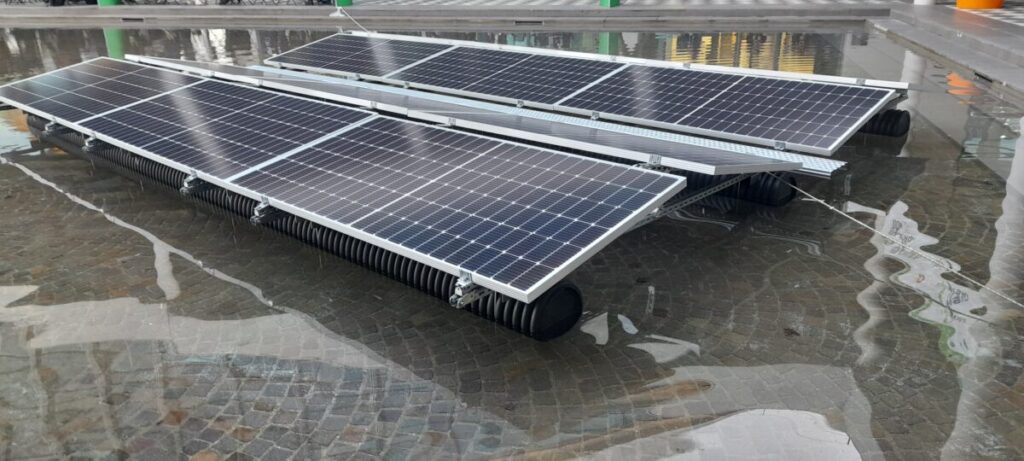Researchers have investigated the aerodynamic performance of a single floating PV setup of 16 panels, as well as an array that combined 15 such setups. They discovered that dragcoefficient distributions and wind pressure effects on PV systems vary per inlet angle. They have also identified cost -saving opportunities by material optimization.
A research group led by the National Taiwan University of Science and Technology Scientists has investigated the aerodynamic performance of floating photovoltaic (FPV) systems at various wind speeds and turbulence intensities and has identified cost -saving opportunities.
“This study offers a detailed wind tunnel research from a scaled offshore FPV system, which offers critical insights into its aerodynamic behavior in both one -off island and ranked configurations under various wind conditions and turbulence intensities,” the group said. “It emphasizes the significant impact of the wind-induced drag and lift forces on the structural integrity of FPV systems, especially in extreme offshore scenarios such as hurricanes.”
Both the single island and Array configurations were manufactured as models of 1/50 scale. The island was signed as a floating unit with 16 PV panels. It had dimensions of 19.5 cm long, 9.5 cm wide and 3.8 cm high.
While the only island served as the basis for understanding the different forces, the island series was designed to study the interaction effects between several PV units. More specifically, it included 15 single island models in a 3 x 5 configuration, with a horizontal area of 60 cm x 60 cm.
Experimental results
“The FPV system models were tested in a controlled wind tunnel environment. The test part of the wind tunnel measures 2.2 m wide, 1.8 m high and 12.0 m long, together with the Array model of the PV panel placed in the middle of the test section with a diameter of 3 m and 4.5 m away from the inlet, “the academics explained. “To simulate realistic offshore wind conditions, two turbulence intensities were generated using gratings placed at 1.8 m and 2.0 m upstream of the front edge of the end plate.”
Data -acquisition used the 56 print claps that each model had. Those holes were placed strategically and the pressure she experienced was transferred to an acrylic disc through the steel tube and then transferred through the plastic hose to the printing scanner. The sampling time of wind pressure measurement was set at 5 minutes and the sampling frequency was set at 300 times per second.
The experimental tests showed that dragcoefficient distributions and wind pressure effects on PV systems vary per inlet angle. “Positive and negative pressure creates power pairs that influence panel rotation,” the team emphasized. “Lower wind corners experience stronger disturbances due to turbulence, especially on windward surfaces, while higher corners reduce disturbances and suction effects. In general, the wind pressure changes considerably with smaller corners, which decrease as the angle increases. “
More specifically, at 0 ° and 30 ° inlet angles, the negative pressure at the top and positively on the bottom surface increases the resistance, further enhanced by turbulence. At 60 ◦, dragging rises slightly as a result of pressure healing, while 90) reduces the pressure balance. “Lifting forces low at 0 °, with turbulence at 30 °, peak at 60 °, and decrease again at 90 °, even under turbulent conditions,” they added.
Economic
The group also discovered that turbulence considerably reduces the average wind coefficient, a measurement that describes how much wind power works on the panels. The results showed that a higher river turbulence reduced the coefficient by 70-80% compared to lower turbulence. “Smaller corners experience stronger wind disorders, which strengthens turbulence. Turbulence increases the total wind load and variability between wind corners, which influence aerodynamic forces, “the researchers emphasized.
As far as the financial aspect is concerned, the team has compared two types of polyethylene that are often used in PV systems to support arrays of solar panel-polyethylene with high density (HDPE) and medium-density Polyethylene (MDPE). Although the first wider is used because of the strength, the latter offers a more cost -effective alternative.
“The replacement of HDPE by MDPE in central areas, where dragging and lift forces are lower, can reduce system costs by 10.2%,” the group said. “This substitution balances strength and costs, making larger floating PV systems more economical and efficient.”
The results were presented in “Experimental research and economic evaluation of wind effects on the solar panel Array of a floating photovoltaic (FPV) system about different turbulence intensities“Published in Energy Nexus. Apart from the National Taiwan University of Science, researchers from Taiwan’s Industrial Technology Research Institute conducted the study.
This content is protected by copyright and may not be reused. If you want to work with us and reuse part of our content, please contact: editors@pv-magazine.com.

